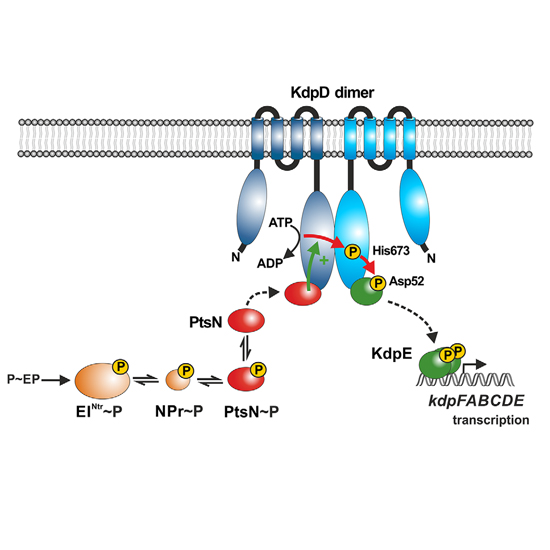Non-canonical activation of histidine kinase KdpD by phosphotransferase protein PtsN through interaction with the transmitter domain
31-Jul-2017
Molecular Microbiology, Volume 106, Issue 1, Pages 54–73, DOI: 10.1111/mmi.13751
Molecular Microbiology, online article
The two-component system KdpD/KdpE governs K+ homeostasis by controlling synthesis of the high affinity K+ transporter KdpFABC. When sensing low environmental K+ concentrations, the dimeric kinase KdpD autophosphorylates in trans and transfers the phosphoryl-group to the response regulator KdpE, which subsequently activates kdpFABC transcription. In Escherichia coli, KdpD can also be activated by interaction with the non-phosphorylated form of the accessory protein PtsN. PtsN stimulates KdpD kinase activity thereby increasing phospho-KdpE levels. Here, we analyzed the interplay between KdpD/KdpE and PtsN. PtsN binds specifically to the catalytic DHp domain of KdpD, which is also contacted by KdpE. Accordingly, PtsN and KdpE compete for binding, providing a paradox. Low levels of non-phosphorylated PtsN stimulate, whereas high amounts reduce kdpFABC expression by blocking access of KdpE to KdpD. Ligand fishing experiments provided insight as they revealed ternary complex formation of PtsN/KdpD2/KdpE in vivo demonstrating that PtsN and KdpE bind different protomers in the KdpD dimer. PtsN may bind one protomer to stimulate phosphorylation of the second KdpD protomer, which then phosphorylates bound KdpE. Phosphorylation of PtsN prevents its incorporation in ternary complexes. Interaction with the conserved DHp domain enables PtsN to regulate additional kinases such as PhoR.











